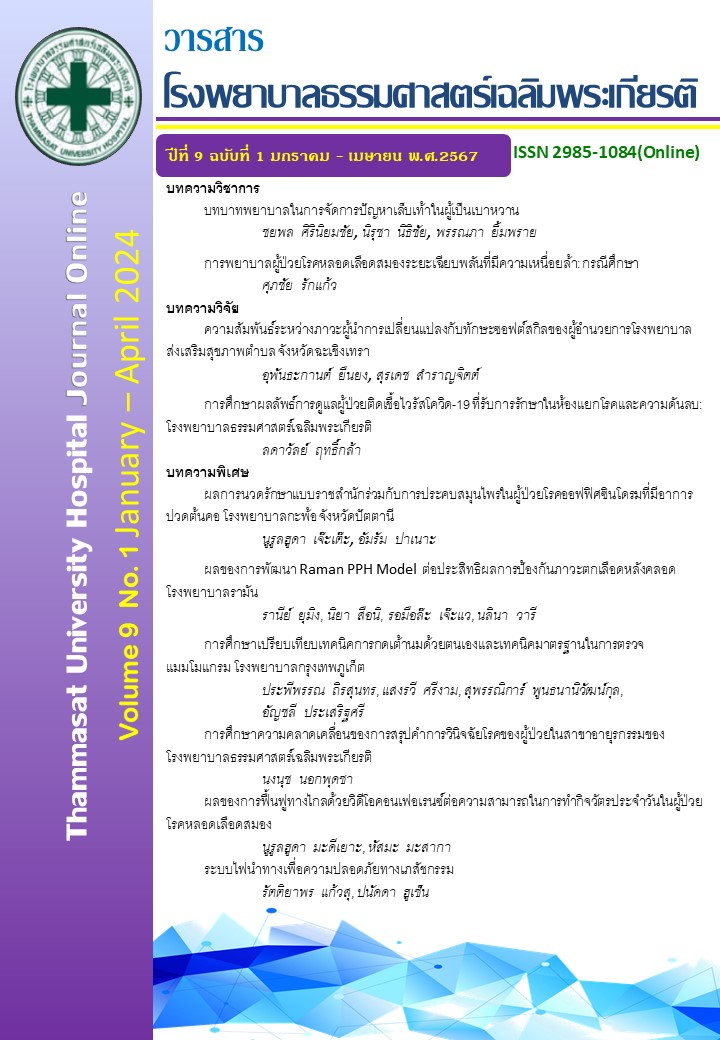The Effect of “Raman PPH Model” to Prevent Postpartum Hemorrhage in Raman Hospital
Keywords:
Postpartum Hemorrhage, Raman PPH Model, Postpartum Hemorrhage PreventionAbstract
Background: Through the analysis of data on related diseases in childbirth units at Raman Hospital, Postpartum hemorrhage is a significant problem with an increasing trend. The annual incidence of postpartum hemorrhage in 2019-2022 was 2.08, 2.04, 0.84 and 1.54 respectively.
Objectives: The research and development study aims to investigate the situation of postpartum hemorrhage, shock, and maternal mortality rates related to postpartum hemorrhage. The goal is to create and enhance a nursing model for preventing postpartum hemorrhage, examining the effects of the developed nursing model before and after using the "Raman PPH Model."
Material and methods: The research had been conducted from 1 September 2018 to 31 May 2023 purposive sampling comprising 1) 12 professional nurses and 2) pregnant women delivering at Raman Hospital. The tools used for developing the nursing model "The Raman PPH Model" included 1) guidelines for caring for pregnant women at risk of postpartum hemorrhage, 2) risk assessment tools based on medical standards, and 3) innovations for preventing postpartum hemorrhage. The data collection tools consisted of recording forms for maternal postpartum hemorrhage incidents and 2) an assessment form of the Raman PPH Model for registered nurse, which was a checklist form.
Results: The Raman PPH Model guidelines improved the assessment and diagnosis of postpartum hemorrhage risks comprehensively and rapidly. Following the Raman PPH Model, 95% of the rate of adherence to preventive measures increased, resulting in a 0.77% decrease in postpartum hemorrhage rates and a 0.24% incidence of shock due to postpartum hemorrhage.
Conclusion: The "Raman PPH Model" guidelines effectively prevent postpartum hemorrhage and requires implementation from the antenatal care, antepartum, labour and postpartum period.
References
World Health Organization, UNICEF.Trends in maternal mortality: 1992 to 2015:estimates by WHO, UNICEF, UNFPA. The World Bank and the United Nations Population Division.[Internet]. 2015 [cited 2022 august 10] Available from: https://apps.who.int/iris/bitstream/handle/10665/112682/9789241507226.
นิลวรรณ อุ่นคำ. การพยาบาลมารดาที่มีภาวะตกเลือดระยะหลังคลอดและภาวะช็อค.โรงพยาบาลกาฬสินธุ์:กรณีศึกษา. วารสารอนามัยสิ่งแวดล้อมและสุขภาพชมุชน.2565; 7(3):196-205.
ราชวิทยาลัยสูตินรีแพทย์แห่งประเทศไทย. แนวทางเวชปฏิบัติ เรื่อง การป้องกันและรักษาภาวะตกเลือดหลังคลอด.[อินเตอร์เน็ต]. 2563 [เข้าถึงเมื่อ 9 มีนาคม 2565]. เข้าถึงได้จาก:http://www.rtcog.or.th/home/wp-Content/uploads/2020/09/OB-63-020-Prevention-and-Management-of-PostpartumHemorrhage.pdf.
พิกุล บัณฑิตพานิชชา. การพัฒนาระบบการพยาบาลในการป้องกันภาวะตกเลือดหลังคลอด. วารสารการแพทย์โรงพยาบาลศรีสะเกษ สุรินทร์ บุรีรัมย์. 2560; 32(2):131-144.
พิรุฬห์ สิทธิพล. การพยาบาลผู้คลอดที่มีภาวะช็อกจากการตกเลือดหลังคลอด: กรณีศึกษา. วารสารสำนักงานสาธารณสุข จังหวัดมหาสารคม. 2063; 4(8): 277- 292.
วรรณภา ปราบพาล, โสมภัทร สรไชย. การพัฒนากระบวนการคัดกรองความเสี่ยงต่อภาวะตกเลือดหลังคลอด โรงพยาบาลบึงโขงหลง. วารสารการพยาบาลกระทรวงสาธารณสุข. 2556: 24(1): 56-66.
พิมลพันธ์ เจริญศรี, วาสนา สารการ, บาลิยา ไชยรา. การพัฒนารูปแบบการพยาบาลหญิงตั้งครรภ์เพื่อป้องกันภาวะตกเลือดหลังคลอดระยะแรกในโรงพยาบาลสรรพสิทธิ. วารสารการพยาบาลและการดูแลสุขภาพ. 2560; 35(3): 48-57.
สุนันทา เอ๊าเจริญ. ประสิทธิผลการป้องกันภาวะตกเลือดหลังคลอดตามแนวทางสามพรานโมเดลโรงพยาบาลสามพราน จังหวัดนครปฐม. วารสารศิลปะการจัดการ. 2562; 2(3):125 – 14.
Downloads
Published
How to Cite
Issue
Section
License
Copyright (c) 2024 Thammasat University Hospital Journal Online

This work is licensed under a Creative Commons Attribution-NonCommercial-NoDerivatives 4.0 International License.


